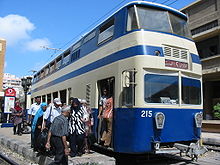Double-decker tram: Difference between revisions
Wickifrank (talk | contribs) added Pittburgh Railway info |
|||
| Line 11: | Line 11: | ||
From 1910 to 1964 double-deck trams were in use in [[Mumbai]] ([[Brihanmumbai Electric Supply and Transport Undertaking]]). They were also in use in [[Johannesburg]] where trams were operational from 1906 to 1961. A few of [[Alexandria Tram]]'s fleet are double-deckers. |
From 1910 to 1964 double-deck trams were in use in [[Mumbai]] ([[Brihanmumbai Electric Supply and Transport Undertaking]]). They were also in use in [[Johannesburg]] where trams were operational from 1906 to 1961. A few of [[Alexandria Tram]]'s fleet are double-deckers. |
||
Double Deck cars were used by the [[Pittsburgh Railways]] ( streetcar / interurban) between 1913 and 1924. A rare use of such cars in the USA. <ref>"Transit In The Triangle, Vol I - 1900-1964", Toman & Hays, c.2012. From page 214 |
|||
</ref> |
|||
==Manufacturers== |
==Manufacturers== |
||
Revision as of 14:12, 18 September 2017
This article needs additional citations for verification. (September 2017) |





A double-decker tram is a tram that has two levels. Some double-decker trams had open tops. Double-deck trams were once popular in some European cities, like Berlin and London, throughout the British Empire countries in the early half of the 20th century including Auckland, Christchurch and Wellington in New Zealand; Hobart, Tasmania in Australia and in parts of Asia. They are still in service in Hong Kong, Alexandria, Dubai and Blackpool. With Hong Kong maintaining the world's only fully double-decker fleet. The historical tramway in Auckland, New Zealand also operates a restored double decker tram that operated in 1906 [1] and has another in storage.
The earliest double-deck trams were horse drawn. The first electric double-deck trams were those built for the Blackpool Tramway in 1898, one of which survives at the National Tramway Museum. They were common in the United Kingdom until the 1950s. London Transport was a heavy user of double deck trams until the system closed in 1952. Apart from the Blackpool tramway, the Glasgow Corporation Tramways were the last to close (in 1962). Some have been preserved at the UK's National Tramway Museum, New Zealand's MOTAT Museum in Auckland and Ferrymead Museum in Christchurch. The last double deck tram built in Britain was Blackpool "Jubilee" Class No.762, which entered service in 1982. Although it used parts from older cars, it was considered to be an entirely new tram. On this basis, when it was retired in 2011, it was gifted to the National Tramway Museum, Crich.
From 1910 to 1964 double-deck trams were in use in Mumbai (Brihanmumbai Electric Supply and Transport Undertaking). They were also in use in Johannesburg where trams were operational from 1906 to 1961. A few of Alexandria Tram's fleet are double-deckers.
Double Deck cars were used by the Pittsburgh Railways ( streetcar / interurban) between 1913 and 1924. A rare use of such cars in the USA. [2]
Manufacturers
- English Electric and United Electric Car
- Glasgow Corporation Tramways
- Dick, Kerr & Co.
- Hong Kong Tramways
- Blackpool tramway - rebuilt English Electric cars
- Brush Engineering Falcon Works
- Rouse, Black and Son, Wellington NZ
See also
References
- ^ Digital, Born. "http://www.motat.org.nz/collection/collection-online/tram-no-47-double-decker-542313/". Motat. Retrieved 2016-10-02.
{{cite web}}: External link in|title= - ^ "Transit In The Triangle, Vol I - 1900-1964", Toman & Hays, c.2012. From page 214
External links
 Media related to Double-decker trams at Wikimedia Commons
Media related to Double-decker trams at Wikimedia Commons
